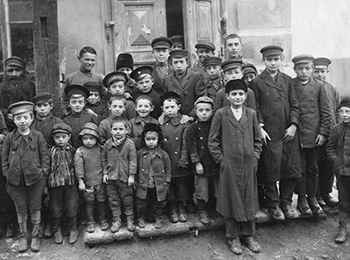For Jews and non-Jewish Ukrainians, divergent narratives have arisen around some of Ukraine’s historical events.
A Journey through the Ukrainian-Jewish Encounter: From Antiquity to 1914, is a traveling exhibition developed by the Ukrainian Jewish Encounter (UJE), a private, multinational initiative. Slated to visit four Canadian cities between late May and September, it seeks to give greater context to and showcase varying perspectives on important historical incidents that have shaped the Ukrainian-Jewish relationship.
The exhibit, which launches in Toronto May 28 at the Schwartz/Reisman Centre, Lebovic Campus, explores 2,000 years of Jewish presence on Ukrainian lands.
Through maps, books, photographs, posters and videos, it chronicles the parallel existences, struggles and transformations, as well as the cultural intermingling, of non-Jewish Ukrainians and Ukrainian Jews up to 1914.
The exhibit will run until June 7 at the Schwartz-Reisman Centre and will move to Winnipeg’s Oseredok Ukrainian Cultural Centre for two weeks before returning to Toronto July 7 to 19 to be shown at St. Vladimir’s Institute.
It will visit Edmonton and Montreal in September.
“One of the UJE’s main goals is to create a shared historical narrative,” said Alti Rodal, UJE’s co-director and exhibit curator. “The two peoples have created separate narratives about the events of the past – particularly in times of crisis or violence – and one of our main goals is to have top scholars from Israel, North America and Ukraine come together and deal with issues about which there are different points of view…and reach an agreement, where possible, using evidence-based historical facts.”
The UJE has already hosted a series of roundtable discussions on some of these topics with scholars of varying backgrounds, Rodal, a former professor of Jewish history at Concordia University, said.
The records of discussion that have emerged from these talks are in the process of being turned into a tangible “shared narrative,” the content of which has helped inform the exhibit.
One controversial event the exhibit highlights is the Chmielnicki (Khmelnytsky) Massacre of 1648-9, when Ukrainian Cossacks, led by Bogdan Chmielnicki, rose up against Polish rule and massacred tens of thousands of Ukraine’s Jews, who were known – and resented for – collecting duties and taxes on behalf of Polish landlords and bankers.
“For Ukrainians, Chmielnicki is a hero; from the Jewish perspective, he’s a villain,” explained Rodal. “Today, neither side looks at the other side, they just see their own perspective. Today in Ukraine, Chmielnicki is on a bank note and there’s a major statue of him in Kiev. For Jews who visit Ukraine and see his image everywhere, they’re taken aback.”
The “difference in Ukrainian versus Jewish memory,” as well as scholarly input on the subject, will be given prominence, Rodal said.
The exhibit is divided into four parts: the first features life in the territory that is today’s Ukraine from antiquity to the partitioning of Poland in 1772; the second focuses on the chassidic movement, which originated on Ukrainian lands; and the final two examine the experiences of the then stateless Ukrainians and Jews in the Russian Empire and under Austrian Habsburg rule, respectively.
Several of the videos shown are the UJE’s original creations, Rodal said, and deal with subjects like sites where Ukrainians and Jews encountered one another – like marketplaces, inns and taverns – and the everyday work of Jewish artisans in a range of crafts.
The UJE was launched in 2008 as a collaborative project between Ukrainians of Jewish and Christian – or other – heritages, and operates in Ukraine, Israel and various diasporas.
Funded and chaired by Canadian businessman of Ukrainian descent James Temerty, the UJE works to promote stronger relations and understanding between the two peoples by engaging scholars, civic leaders, artists, governments and the public.
Three years ago, the UJE got some funding from the Canadian government to undertake several projects, including launching a website, creating a book of articles and developing the exhibit in question.
Rodal said the UJE made a point of showing the exhibit at major Jewish and Ukrainian centres in Canada.
Edmonton, for example, has a small Jewish community, she noted, but “a huge Ukrainian community.”
Exhibit hours at the Schwartz/Reisman Centre are Sunday, Wednesday and Thursday, 10 a.m.-8 p.m.; Monday and Tuesday, 1 p.m.-8 p.m. and Friday, 10 a.m.-4 p.m.
The exhibit is free.
***This article was modified from its original form to fix some errors.
